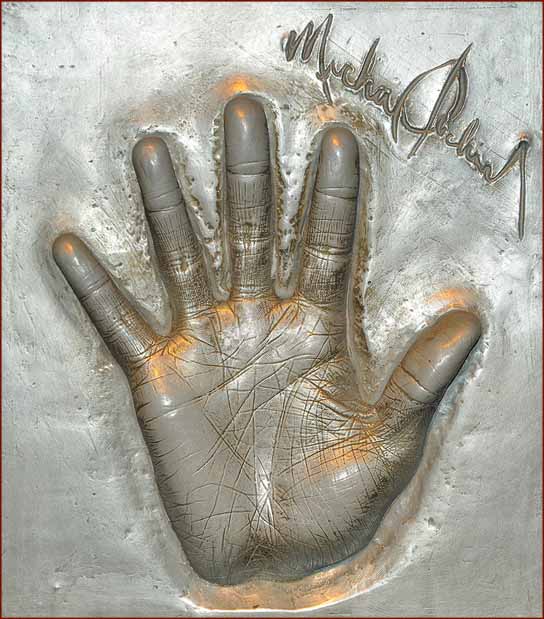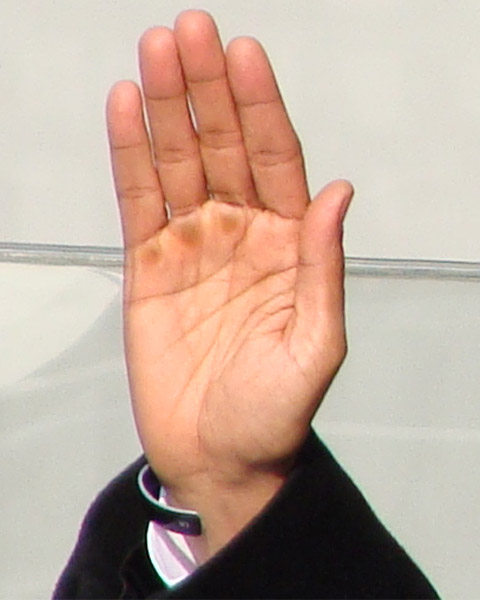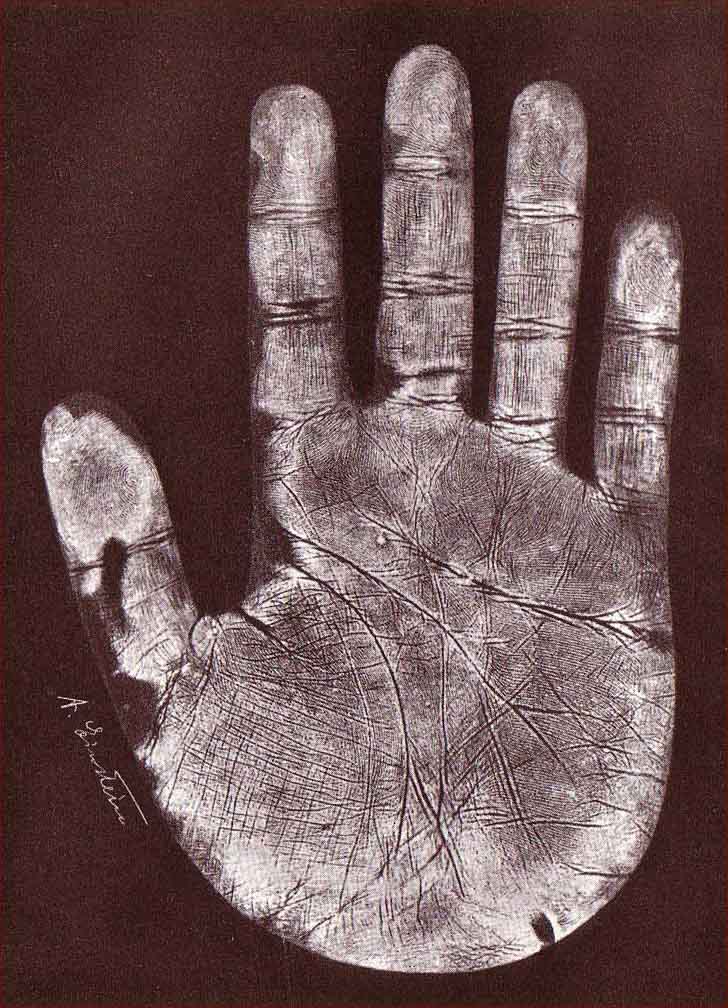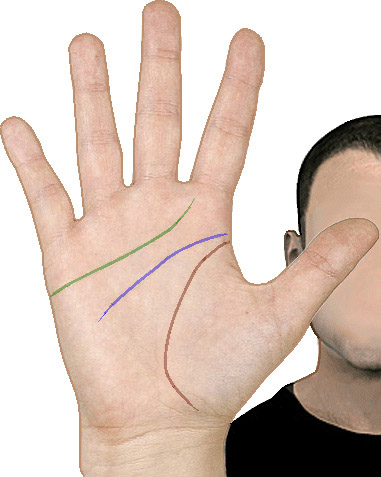|
LEARN TO RECOGNIZE & UNDERSTAND THE MOST IMPORTANT LINES IN THE PALM OF YOUR HANDS! The advanced version of the 'PIC model' is named the 'PIC-SIC model', which is featured with a rating of three additional characteristics of the three 'primary palmar lines', including the presence/absence of: splittings, interruptions and curvation. In the advanced 'PIC-SIC model' the characteristics of the three 'primary palmar creases' are described with a 6-digit 'PIC-SIC code' (for example: '310-000'): the first 3 digits relate to the three basic elements of the 'PIC model', the second 3 digits relate to the three additional characteristics 'PIC-SIC MODEL' ESSENTIALS: Each hand can be described with a 6-digit 'PIC-SIC code', composed by the number of: • P - Primary lines [varies from: 1 to 3]; • I - Intersections between primary lines [varies from: 0 to 2]; • C - Complete transversal primary lines [varies from: 0 to 2]; • S - Splittings [varies from: 0 to 3]; • I - Interruptions [varies from: 0 to 3]; • C - Curvation missing [varies from: 0 to 3]; Ad digit 1-3) See the 'PIC model' basics. Ad digit 4) Splittings are only counted as such when these can be observed in the 'core' of any of the three 'primary palmar lines' (splittings of accessory lines from the 'core' should be ignored). For each of the lines this characteristic is rated with a 'yes' or a 'no'; every 'yes' is summarized resulting in a score that may vary from 0 to 3. Ad digit 5) Interruptions are only counted as such when these can be observed in the 'core' of any of the three 'primary palmar lines' (minor interruptions which do not show a clear change in the path of the 'core' should be ignored). For each of the lines this characteristic is rated with a 'yes' or a 'no'; every 'yes' is summarized resulting in a score that may vary from 0 to 3. NOTICE: The presence of a very explictely clear DOUBLE head line (to be recognized by the presence of 2 independent lines which each display all basic characteristics of a typical head line) can be understood and rated as a combination of: 'splitting' + 'interruption'! [The same approach can be used for a DOUBLE heart line or a DOUBLE life line] Ad digit 6) Curvation is only counted when this characteristic is MISSING! The lack of curvation is only counted when any of the three 'primary palmar lines' shows the characteristics of an unnaturally (straight) path (minor curvation is only natural, and should be ignored here!). For each of the lines this characteristic is rated with a 'yes' or a 'no'; every 'yes' is summarized resulting in a score that may vary from 0 to 3. NOTIFICATION: Splitings, interruptions & curvation (Ad 4 - Ad 6) can be specified for each of the three 'primary palmar lines' with the following codes: a = head line; b = heart line; c = life line; a+b = head line + heart line; a+c = head line + life line; b+c = heart line + life line; a+b+c = head line + heart line + life line. 'PIC-SIC MODEL' CLASSIFICATIONS: THE HAND OF NELSON MANDELA 
• PIC CLASSIFICATION: '310' • PIC-SIC CASSIFICATION: '310-000' PIC-SIC ANALYSIS: Ad 1 - All three 'primary palmar lines' are present (= 3); Ad 2 - head line is connected to life line (= 1); Ad 3 - no complete transversality (= 0); Ad 4 - no splittings (= 0); Ad 5 - no major interruptions (= 0); Ad 6 - no abnormal curvations (= 0). ADDITIONAL COMMENT: - THE HAND (CAST) OF MICHAEL JACKSON 
• PIC CLASSIFICATION: '310' • PIC-SIC CASSIFICATION: '310-2a+b00' PIC-SIC ANALYSIS: Ad 1 - All three 'primary palmar lines' are present (= 3); Ad 2 - head line is connected to life line (= 1); Ad 3 - no complete transversality (= 0); Ad 4 - splitting of the head line + heart line (= 2a+b); Ad 5 - no major interruptions (= 0); Ad 6 - no abnormal curvations (= 0). ADDITIONAL COMMENT: A rather unusual characteristic in the three 'primary palmar lines' of Michael Jackson's right hand concerns presence of what appear to be 2 head lines; however in this case this characteristic can be deduced to a very early 'splitting' of the head line. There is a minor interruption in the 'second' (distal) head line, but this is not counted as such because the is minor interruption is not featured with a clear change in the path of the line. THE HAND OF BARACK OBAMA 
• PIC CLASSIFICATION: '300' • PIC-SIC CASSIFICATION: '300-000' PIC-SIC ANALYSIS: Ad 1 - All three 'primary palmar lines' are present (= 3); Ad 2 - none of the major lines are connected (= 0); Ad 3 - no complete transversality (= 0); Ad 4 - no splittings (= 0); Ad 5 - no major interruptions (= 0); Ad 6 - no abnormal curvations (= 0). ADDITIONAL COMMENT: - THE HAND (PRINT) OF ALBERT EINSTEIN 
• PIC CLASSIFICATION: '300' • PIC-SIC CASSIFICATION: '300-2a+c00' PIC-SIC ANALYSIS: Ad 1 - All three 'primary palmar lines' are present (= 3); Ad 2 - none of the major lines are connected (= 0); Ad 3 - no complete transversality (= 0); Ad 4 - splitting of the head line + life line (= 2a+c); Ad 5 - no major interruptions (= 0); Ad 6 - no abnormal curvations (= 0). ADDITIONAL COMMENT: - THE HAND OF TONY BLAIR  
• PIC CLASSIFICATION: '211' • PIC-SIC CASSIFICATION: '211-000' PIC-SIC ANALYSIS: Ad 1 - Only two 'primary palmar lines' are present: a complete simian line (= 2); Ad 2 - head line is connected to life line (= 1); Ad 3 - simian line = complete transversality (= 1); Ad 4 - no splittings (= 0); Ad 5 - no major interruptions (= 0); Ad 6 - no abnormal curvations (= 0). ADDITIONAL COMMENT: -
|

